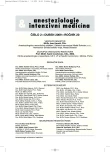Anterior spinal artery syndrome as a complication of neuroaxial blocade – successful treatment with prostacyclin (case report)
Authors:
Stibor Bronislav 1; Schwameis Franz 1; Fellner Hermann 2
Authors‘ workplace:
Abteilung für Anästhesie und Intensivmedizin, Landesklinikum Baden, Baden bei Wien, Rakousko
1; Röntgeninstitut, Landesklinikum Baden, Baden bei Wien, Rakousko
2
Published in:
Anest. intenziv. Med., 20, 2009, č. 2, s. 78-83
Category:
Anaesthesiology - Case Report
Overview
The authors report anterior spinal artery syndrome occurring as a complication of neuraxial blocade. They describe the cause and origin of the syndrome, the clinical symptoms, illness trajectory and its successful treatment. The patient, a 66-year-old man, underwent colon resection of a colonoscopically detected carcinoma. The surgery was carried out under general anaesthesia. An epidural catheter at the L2/3 level was placed preoperatively for peri- and postoperative analgesia. The patient was extubated about 8 hours after catheter placement. Later on, total spinal paraplegia was detected corresponding to the level of the catheter placement. The 3D-CT examination excluded an expansive process in the spinal canal area. Treatment with continuously administered epoprostenol was commenced. Epoprostenol is a prostacyclin with powerful anti-aggregating and vasodilator effects. Neurological symptoms totally disappeared within 9 hours of the beginning of epoprostenol administration and restitutio ad integrum was observed.
Keywords:
anterior spinal artery syndrome – neuraxial blocade – epidural catheter – prostacyclin
Sources
1. Er, U., Fraser, K., Lanzino, G. The anterior spinal artery origin: a microanatomical study. Spinal cord., 2008, 46, 1, p. 45–49.
2. Gövsa, F., Aktan, Z. A., Arisoy, Y., Varol, T. et al. Origin of the anterior spinal artery. Surg. Radiol. Anat., 1996, 18, 3, p. 189–193.
3. Schalow, G. Feeder arteries, longitudinal arterial trunks and arterial anastomoses of the lower human spinal cord. Zentralbl Neurochir., 1990, 51, 4, p. 181–184.
4. Thron, A. K., Mull, M. Blood Vessels of the Spinal Cord: Anatomical and MR-Imaging Correlation. Rivista di Neuroradiologia, 2004, 17, p. 277–281.
5. Černák, V., Ondrejovič, S., Andrejčáková, R. Syndróm arteria spinalis anterior po operácii na brušnej aorte – kazuistika. Anest. neodkl. Péče, 2002, 13, 6, p. 269–270.
6. Soukop, W. Forensischer Fall: Spinalis Anterior Syndrom nach minimalen Wirbelsäulentraumen. J. Neurol. Neurochir. Psychiatr., 2005, 6, 2, p. 37–39.
7. Shamji, M. F., Maziak, D. E., Shamji, F. M., Gingsberg, R. J. Circulation of the spinal cord: an importnant consideration for thoracic surgeons. Am. Thorac. Surg., 2003, 76, p. 315–321.
8. Yuh, W. T. C., March, E. E., Wang, A. K. et al. MR imaging of spinal cord, and vertebral body infarction. Am. J. Neuroradiol., 1992, 13, p. 145–154.
9. http://www.gsk.com/products/index.htm
10. Fukusaki, M. et al. Perineural injection to nerve root and radicular blood flow: a clinical study during spinal surgery. Eur. J. Anaesthesiol., 2001, 18, 2, p. 70–74.
11. Fukusaki, M. et al. Prostaglandin E1 But Not Corticosteroid Increases Nerve Root Blood Flow Velocity After Lumbar Diskectomy in Surgical Patients. J. Neurosurg. Anesthesiol., 2003, 15, 2, p. 76–81.
12. Beilin, Y. et al. The optimal distance that the multiorifice epidural catheter should be threaded into the epidural space. Anesth. Analg., 1995, 81, 2, p. 301–304.
Labels
Anaesthesiology, Resuscitation and Inten Intensive Care MedicineArticle was published in
Anaesthesiology and Intensive Care Medicine

2009 Issue 2
Most read in this issue
- Anaphylaxis after induction to general anaesthesia: Four case reports
- Erythropoietin and other erythropoiesis-stimulating drugs and bloodless medicine – a new era in the management of anaemia?
- Anterior spinal artery syndrome as a complication of neuroaxial blocade – successful treatment with prostacyclin (case report)
- A fatal complication of tracheostomy in a 13-year-old patient with Duchenne Muscular Dystrophy – case report
